#USDA Zone 7a
Text
food & agriculture in fallout: extrapolation and speculative worldbuilding
Okay, well. This is going to be an extremely long and data heavy post. Bear with me.
I'm going to go into detail about the crops and available food given to us canonically and textually. I'm going to be drawing some real world parallels between the crops we see in Fallout and what we have here. I'll be pulling relevant data from all the games, but the majority focus on this post is going to be about the east coast and Massachusetts in particular because it gives us the opportunity to participate in the agricultural climate of the wasteland.
Is there a point to this? Not really, but I'm pedantic and I take things too seriously.
my sources will be linked in the text throughout. for those of you who want to read about agricultural and growing zones of the continental united states, please follow me under the cut.
Growing zones and real world agriculture
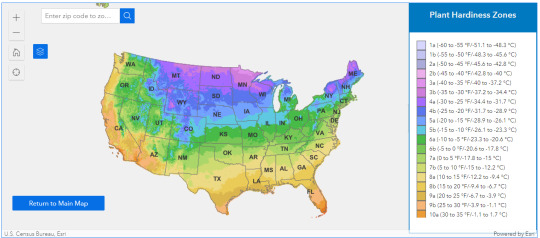
Shown here are the growing zones of the united states, divided into a temperature map of about 19 different regions. It's fairly intuitive to read -- colder temperatures are north and east, while warmer temperatures are south and west. The majority of the Mojave desert sits between 7a to 9a, a temperature range of about 20 degrees. DC and the nearby section of the southeast coast sits between 7a and 8a. The interactive map linked below will tell you where your growing zone sits.
The 2012 USDA Plant Hardiness Zone Map is the standard by which gardeners and growers can determine which plants are most likely to thrive at a location. The map is based on the average annual minimum winter temperature, divided into 10-degree F zones and further divided into 5-degree F half-zones.
For the moment, we are going to focus on Massachusetts.

Using the temperature above, we can see that the growing zone of Massachusetts is 5a (-20f) at it's very coldest, all the way to 7b, (5f) at it's warmest during winter. Most of what we see in fallout 5 sits in the 6a to 6b zone, which is middle ground during the winter, but cold enough to want to warrant crops that can withstand the frost.
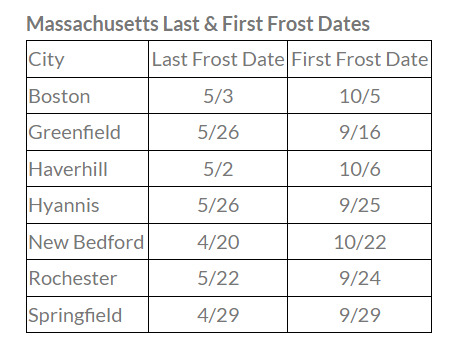
There is a solid 5 month window for planting annual crops, like corn, melons, and gourds like pumpkin. Your perennial crops are limited to fruit trees and possibly grains, depending on the variety and whether or not a perennial variety has been bred.
Cold weather crops include beets, carrots, greens like cabbage, collards, kale, and potatoes. These aren't the types of crops that will survive the winter as much as these are foods that can go in the ground as soon as it is unfrozen enough to be workable. Root vegetables and greens can germinate in soil as cold as 40 degrees Fahrenheit, which provides some leeway with unpredictable frosts and late planting times.
Much of the agricultural landscape of Massachusetts is dependent on the dairy industry, farming cattle, and aquaculture -- fishing and catching shellfish. Those with access to the coasts, fish and shellfish ought to provide protein during lean months.
Why are we talking about this? Well, if we're stepping into the shoes of a subsistence farmer in the fallout universe, we're going to have to take into account climate and ideal planting times for certain crops. It's not wholly important in terms of things like fic writing, unless you happen to be writing about the life and times of wasteland agriculture, in which case, I hope this is helpful! Again, I am pedantic, and this section is to provide a template when considering and discussing other parts of the game and what their specific diet and agricultural landscapes might look like.
Something to keep in mind when thinking about how farms might function in the Mojave, for instance, or if you're doing worldbuilding for a different part of the US.
Crops in the fallout universe
Now that we're familiar with growing zones and why certain crops are planted and when, we're going to apply some speculative worldbuilding to fallout itself. We will be revisiting growing zones when we talk about other climates, but for the moment, we're going to focus on fallout 4.
Now to preface -- I don't think that the food that is given to us in game is wholly representative of the plants or animals that survived the apocalypse. If some managed to mutant and survive, I'm willing to bet others did. I certainly won't deduct any points from anyone who wants to talk about growing cotton, or farming peaches or cherries, and I won't raise any eyebrows if someone includes things like spices into their wasteland cuisine.
In the 210+ years since the bombs fell, I do not think that the majority of the US is a desolate wasteland, but this post is not going to be my beef with the devs about how brown everything is. This beef is about food in particular. However, for sake of ease, I'm mostly just going to focus on the food that is presented to us in game.
There will be some extrapolation and speculation later, but if I do that for everything, then we'll be here all day, and we've all got things to do.
I would also be remiss to mention that agriculture in the US is old. It predates colonialism. The Native Americans cultivated the land long before any European settlers. They practiced a type of crop growing referred to as Three Sisters planting, which utilized corn, pole beans, and squash -- all things that exist in the agricultural landscape of Fallout as we know it.
Corn
I'm not going to say much about corn because there's not a lot to say about it. We all know what corn is. Fallout's corn is visually similar to wild violet, a hybrid corn.

But I am not going to say Fallout's corn is one such variety or another. In the 210 years since the bombs dropped, I imagine corn varietals have been bred and interbred a thousand times, and it is probably it's own unique strain. It's kind of a moot point. Corn is corn. You can do with yellow corn what you can do with wild violet, and whatever special breeds that make up Fallout's corn.
Corn is the third largest plant-based food source in the world. Despite its importance as a major food in many parts of the world, corn is inferior to other cereals in nutritional value. Its protein is of poor quality, and it is deficient in niacin. Diets in which it predominates often result in pellagra (niacin-deficiency disease). Corn is high in dietary fibre and rich in antioxidants.
You can do a shit ton with corn. It's a staple grain. It would not be incongruous with the fallout setting to have settlers making tortillas, cornbread, polenta, grits, tamales, etc. Corn can also be used to make corn whiskey. The husks can be spun into yarn and woven into garments similar to cotton, which I thought was interesting and also solves the problem of where the hell wastelanders are getting their clothes. Corn can be used as livestock feed, especially in the winter when cattle can't graze. While corn is a staple grain of the US, the east coast has minor corn production compared to places like the midwest. Corn is a staple, but it does not consist of the entire diet of your average wastelander.
Carrots
Not going to say much about carrots either. They're carrots. They grow well in colder soil and tend to have a lot of natural sugars. The carrots we're shown in FO4 seem to be a mutated variety different than the "fresh carrot" consumable in FNV, but there's virtually no difference, so I'm not counting it. Make some carrot cake.
Razorgrain
"This species appears to be quite promising. It's a toothy grain that we may be able to grind in order to replace wheat, which is untenable in the Wasteland. We are uncertain how to increase crop yields, which are very unpredictable. Will continue to study."
Razorgrain is our first unique mutated crop in the fallout setting. It most closely resembles a barley or a rye. Both are a fairly hardy species and can grow all across the continental united states; rye can germinate in cold weather temperatures. It wouldn't be outrageous to assume that razorgrain is similar too or a crossbred variation of both rye and barley. I have decided to base the majority of my research assuming it is a barley variant. Barley is also a major crop on the east coast near the Commonwealth, so that would explain why razorgrain is present in FO4 and not in the other games.
Barley requires a mild winter climate and can grow in growing zones 3-8, so it would be viable in Massachusetts. Barley can be milled into flour and it contains gluten; the gluten content of North American wheat and barley tends to be higher to survive the colder climates, so razorgrain would likely be very glutenous. It is also less susceptible to ergot than rye, but barley can still become infected -- and, I am assuming, razorgrain could as well.
Razorgrain fills the nutritional niche of carbohydrates and can be used to make breads, cakes, pastas, etc. It produces darker breads that have an earthier flavor than milled white flour. There has to be some method of actually milling the grain, though, which is an intensive process that can often be dangerous. Grain can also be used to make malted candy, which is our first option for wastelanders with a sweet tooth. Obviously, razorgrain can also be used to make malt or grain alcohol and is probably the source of all the beer you find littered around the wasteland.
Gourds and melons
Gourds and melons are actually a part of the same family, Cucurbita. The category of 'gourd' covers several different kinds of vegetables, including ornamental fruits that shouldn't be eaten. We aren't going to spend a whole lot of time on this one, simply because canon doesn't tell us that much and there's a lot of wiggle room in terms of interpretation.

FO4's model looks the most similar to a pumpkin, but it could be some other squash varietal from the Cucurbita family, which includes watermelon, honey melon, cucumber, squash, zucchini and pumpkin.
Melons is another pretty broad category. Melons and squash are part of the same family, as mentioned above. If we're going visuals again, the model is likely intended to resemble a watermelon. Watermelons grow best in humid and semi-arid environments between 70 and 8- degrees Fahrenheit. It's not impossible for wastelanders to be growing watermelons, but considering the humidity and frequent rainfall in Massachusetts, the melons would be vulnerable to fungal infections.
There isn't a lot of information on what specifically gourds and melons are in the fallout universe, so you could get away with writing in a pretty wide variety. Personally, I lean a little bit towards melons being a muskmelon variety, like cantaloupe or honeydew. Squash fills in some vitamin requirements for the human diet, and can be canned and stored for winter. It tends to be high in vitamin C and magnesium.
The limit to this one seems to be your imagination. Go crazy.
Mutfruit
This wiki claims that the mutfruit (it has a scientific name apparently, malus maata) is a mutated species of apple and crabapple. There are two different wikis about the mutfruit, both distinct. The first is linked above. The second is linked here -- I got most of my information from this second wiki.
There is a handful of "canon" information we can take from this set of wikis.
Priscilla Penske in Vault 81 is attempting to create foods that have increased resistance to radiation. She mentions the mutfruit would do well, but isn't certain how the hybridization would affect the flavor and texture.[5]
This claim is taken directly from the second wiki, but in comparison, it makes no sense. If the mutfruit tree is a product of mutation, then radiation shouldn't really affect it at all. It's survived and propagated to this point, hasn't it? I am disregarding this claim on the basis of being stupid.
Farmers in at Warwick homestead will comment on the fruit's characteristics, such as tasting sweet and being versatile in recipes.[1][2]
The vault dwellers of Vault 81 trade for mutfruit with the outside world, and use it to make special occasion desserts such as pie.[6][7]
If the mutfruit is an apple variant, then it likely has a high sugar content, and it would have to be harvested in the peak of summer or in early fall.
There are fresh apples the be found across the wasteland, implying the existence of apple trees that have been unaffected by the bombs. Personally, I was assuming that the mutfruit was some kind of blackberry, given its appearance as a clustered fruit, or maybe even a type of plum. Regardless, the mutfruit is a fruit, which means that it would preserve well by being jarred or canned, has a high sugar content, and could likely be reduced to form sugar syrups. Like any fruit, it could be used to make alcohol.
Tatos
I want to stop myself from editorializing too much, but goddamn tatos. The crop that makes the least goddamn sense in the fallout universe. The bane of my existence. Let's get into it.
First off, we're given some pretty damning canon facts about tatos:
Tatos are a mutated hybrid of the cross-pollination of the tomato and potato plants.[1] The new consumable looks like a tomato on the outside, but the inside is brown.[2] Commonly cultivated in the Commonwealth, Appalachia and on the Island, its fruit is easy to grow and can keep one from starving, but their taste is described as "disgusting"[2][3][Non-game 1] and resembling "ketchup-flavored cardboard."[1]
According to some old botany texts we found, this appears to be combination of a now extinct plant called a "potato" and another extinct plant called a "tomato." The outside looks like a tomato, but the inside is brown. Tastes as absolutely disgusting as it looks, but will keep you from starving.
Note: This text was written from the perspective of someone who is unaware that both the tomato and the potato are being cultivated elsewhere. The writer also does not mention any sort of DNA test. However, the potato is also found in the Capital Wasteland, and the writer is a scribe in the Brotherhood of Steel, which originated from that area.
Both potatoes and tomatoes are from the nightshade family. They have the same nutrient requirements, and would compete for resources if planted separately but in the same soil. There is a method for planting them together where you splice a tomato stalk onto a potato root, but this is not the same as cross pollination and will not result in what fallout presents as a tato. What will happen is that the roots will grow potatoes and the fruit of the tomato will branch off the stems.
The potato itself is a stem tuber -- high in starch and calorically dense. A stem tuber is an offshoot of the parent plant that will grow beneath the soil as a type of asexual budding reproduction. We all know what a potato is. The tomato is a berry. It's the ovary of a flowering plant -- again, we all know what a tomato is.
I am going to give Fallout a little bit of grace and not comment on how mind bendingly stupid their description of a tato is. The outer skin is a tomato, but the inside is brown and starchy like the potato? I am not going to comment on how it makes little to no biological sense. The starchy tuber is starchy because it's an energy and nutrient storage device. The tomato is the enlarged ovary of a fruit. Why did those things, which are separately very good, combine into one very terrible thing? I don't know. It doesn't make sense. I don't really want to think about it. But these are the facts as they are given to us in game and I suppose I have to live with that. Obligatory "goddamn you todd howard. a pox on your house."
The tato is probably extremely calorically dense. It's specifically mentioned as being easy to grow and it is a better alternative to starving. It's probably grown as a staple crop throughout the planting season. I'm not entirely sure if the tato can produce glycoalkaloids like the potato does (that is, the green sections of the potato that can become poisonous when exposed to light) but if they can, and if stored improperly, it would negatively impact the health of whoever ate them.
I suppose since the taste is so offensive, tatos are better served as a carrier of some other type of food. Fried, mashed, baked -- the purpose of the tato is simply to get calories into your body. Starch can also be turned into alcohol, which I am going to need a lot of after reading the canonical facts of this stupid fucking plant.
Fallout: The Roleplaying Game Rulebook p.158: "A mutated hybrid of the pre-War tomato and potato plants, with the stem and reddish skin of the former and the brownish flesh of the latter. Tatos provide decent nutrition, but taste disgusting. However, they’re relatively easy to grow and thus are a staple of wasteland agriculture and is an ingredient in a variety of recipes."
fucker
"non farmable" crops
You can't cultivate these plants, but again - we're taking what's given to us and interpreting it extremely literally. There is no reason that these crops could not be domesticated and farmed.
Siltbean
Siltbean is likely a type of bushbean, rather than a pole bean. It's squat and low to the ground. Bush beans require little care or attention and you can pick them when you're ready to harvest them. Historically in North America, beans and corn were grown side by side (though those beans were pole beans using the stalks as support). Bush beans require successive plantings since harvests are early.
There's no good allegory for what type of bean this might be. The potato bean (Apios americana) is native to North America and also produces edible tubers, but there's no reason this couldn't be just some other type of bean. No beans that I could find had red/orange pods.

Beans are a good source of both proteins and carbohydrates, and another crop that can store well for the winter.
Tarberry
Tarberry is a little iffy, considering it is farmed by the ghouls at The Slog, but they're the only farm shown capable (or willing?) to farm the berries. Originally, I had assumed that tarberries were a type of mutated cranberry, and I thought the wiki was supporting me in that claim by saying this:
Tarberries are small, dusty orange berries of the tarberry plant. It is a water-grown crop similar to cranberries.
But cranberries themselves are also canon in the world of Fallout. So who knows! There's no canon information presented on the tarberry's characteristics, so it can be treated the same as any other fruit or berry.
Fungus variants
Glowing fungus: Glowing fungus is one of the few real world equivalents we have. It is a Japanese mushroom called Enoki. It is also farmable as shown in FNV at Hell's Motel.
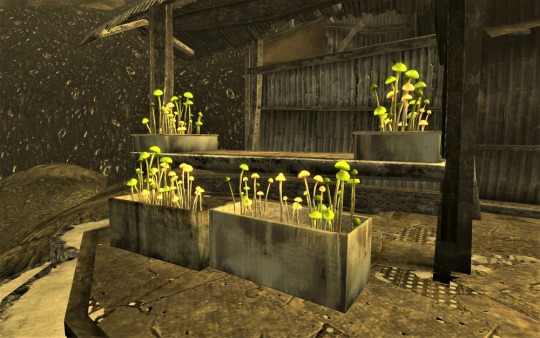
Brain fungus: This is harvestable, but there aren't any "crops" shown as we would consider them. Considering it's benefits as a mentat replacement, then it's likely that there could be a dedicated space for growing it.
Food and Plants mentioned in the text
Potato
Thank god almighty, potatoes are canon in the universe of Fallout. Fresh potatoes are found as consumables in FO3 and FNV but potatoes are also mentioned in the text of FO4:
Mentioned in dialogue -- {Angry} Shut up Jake. If I hear anything out of either of you, you'll both be peeling potatoes for the next year.
I'm taking this as word of god. Potatoes are canon and I don't care what anyone says.
Tomato
Tomatoes are mentioned in the text, but are never actually seen in game. The only hint that this plant survived extinction is this excerpt from the wiki.
Note: As fresh tomatoes and potatoes are seen in the Mojave Wasteland as of 2281, with the potato seen in the Capital Wasteland as of 2277, the claim of either's extinction by 2287 in the Commonwealth Plant Database could be taken to mean local extinction in east coast regions, as opposed to global extinction. This entry may also just be in error.
There's potential for leeway here, but take it as you will!
Fresh apple
We discussed this back up in the mutfruit section of the essay, but the existence of fresh apples implies the existence of non mutated apple trees. They're found in both FO3 and FNV as a consumable item, so the apple tress have either proliferated across the continental united states, or multiple varieties survived the bombs.
Fresh pear
See above. Pears are also naturally high in pectin, which makes them useful for making jams and preserves.
Pinto beans
Pinto beans are a consumable in FNV and is another W in the bean category of the agricultural landscape.
Jalepeno
Look, I'm picking out this one specifically because I need to believe that other spices and peppers exist in the world. Where would we be without her? Nowhere good.
Raw sap
I am going to say that sap collecting is probably where most of the sugars and sweeteners in the wasteland come from. It's relatively easy to tap trees and collect sap, and it only takes a few hours to reduce the sap down into useable syrup.
Wild Blackberry, Lime, Cranberries, as well as Watermelon as being distinct from simply 'melon' are all mentioned in the text. The list of fruits mentioned or found in the games can be found here.
Animal husbandry
Fallout doesn't give us a lot of canonical information on the animal side of farming. The biggest real world agricultural export of Massachusetts is dairy and cattle farming. Chickens are canon in the worldbuilding of fallout as of Far Harbor, but canon feels both restrictive and extremely loose with regards to what animals can be cared for and how.
We aren't going to spend a whole lot of time on this one, only because the information is pretty limited.
Brahmin
There are plenty of brahmin found throughout the landscape of the wasteland. We most commonly see them as either livestock or beasts of burden. Things like milk, cheese, and other dairy products would be common if a farm has access to dairy cows. The investment to raise cows would be enormous for a subsistence farmer. Dairy cows would likely be kept for a number of years, where steers would be raised 12 to 24 months before being slaughtered; they'd likely be grass fed in the summer and corn or grain fed in the winter. Leather and beef would be products, of course, and things like soap and candles can be made from the beef tallow.
Chickens
Chickens are largely easy to keep and care for, producing eggs and necessary proteins. Chickens can provide niacin, filling in the nutritional gap that would be left by a heavy corn based diet. The investment for keeping chickens is lower than raising brahmin, but so is the payoff.
Bighorners
Bighorners are mutated bighorn sheep native to the American Southwest.[1] Humans have since domesticated them for their horns, meat, milk, and hides,[2][3]
Granted, bighorners are only seen in FNV, but I don't think there's any reason they couldn't have migrated east. In the text, it says they're kept for meat and milk, but there's no reason that they shouldn't provide a fleece as well. In the colder climate of Massachusetts, they would find value in wool, which can keep its warmth even when wet. They may be sparse across the commonwealth, but that would make wool and fleece all that much more valuable.
Fish
Yeah, I know. Technically we can't fish in Fallout (and depending on the game you play, you might not even know what a fish is). But aquaculture is huge in Boston, and with access to the coasts, it's completely fair to say that fish, shellfish, and hydroponics is a completely viable source of food in the wasteland. We see dead fish washed up on shore all the time, along with whatever the hell those shark things are. There should be fisheries and fishing towns all along the coasts.
New Vegas and Fallout 3
Consulting our growing zone chart, we can see that much of the southwest sits between 7b to 8b. The winters in the southwest are fairly mild, and while you can get seeds in the ground sooner, the majority of the battle is going to be finding a reliable water source.
The farming we see in New Vegas has one distinct notable inclusion: the NCR sharecropper farm.
The sharecroppers are growing a number of crops, including maize, tobacco, pinto beans, and honey mesquite. Corn can handle hot, arid weather, it's just not commercially grown out west. Barley can also handle hot, arid climates, and razorgrain would be suitable for the western front -- maybe we can assume it's made it's way that far west and is being cultivated alongside corn.
Most of the plants we see in FNV aren't the type we would see typically domesticated for agricultural use, but that doesn't mean people haven't adapted to their surroundings. It makes a lot of sense for locals to have domesticated local plants like prickly pear and banana yucca. There are a number of fresh produce items to be found as consumables, alongside local fruits the local fruits.
Heat-loving plants are best suited for summer production in desert climates. The plant families that fit into the heat-loving category are nightshade or Solanaceae (tomatoes, peppers, eggplant) and squash or Cucurbitaceae (cucumbers, melons, summer and winter squash). Corn and beans also perform best in hot climates.
Most plants CAN handle the heat and climate of the southwest, the issue is just finding a reliable source of water. Somewhere close to Lake Mead or the banks of the Virgin River would be prime real estate for farming, since irrigation could be accomplished without the use of pumps, like the sharecroppers use.
If we look back at the history of agriculture, it's developed along established waterways in almost every ancient civilization because that's what's easiest. There should be thriving communities surrounding the lakes and rivers in the southwest.
Comparatively, DC was formerly a swamp. It's hot and humid in the summer, though the winters are fairly mild. It wouldn't be a stretch to say that farming practices in the Commonwealth don't differ all that much from farming in the Capital Wasteland -- you could even posit that food from the Capital is of better quality ever since the successful activation of Project Purity. Fresh and unirradiated food was growing there before, so it's entirely likely that even more is growing now. YMMV!
Other consumables
We would be here all damn day if I did research onto every single consumable item available across all three games, so this mostly just because I'm covering my bases.
I am going to say that sap collecting is probably where most of the sugars and sweeteners in the wasteland come from. It's relatively easy to tap trees and collect sap, and it only takes a few hours to reduce the sap down into useable syrup.
Look, I'm picking out this one specifically because I need to believe that other spices and peppers exist in the world. Where would we be without her? Nowhere good.
Pre War food
Most shelf-stable foods are safe indefinitely. In fact, canned goods will last for years, as long as the can itself is in good condition (no rust, dents, or swelling). Packaged foods (cereal, pasta, cookies) will be safe past the ‘best by’ date, although they may eventually become stale or develop an off flavor.
The risk with improperly canned good, or damaged canned goods, is botulism. Botulism will straight up kill you. You don't even have to consume that much of it; just a little bit will leave you dead in days. As desperate as I might be for a meal, I'm not going to risk dying because that can of two hundred year old peaches looks really tasty.
If properly sealed and in a dry, ideal environment, I... guess things like cereal and instant food could be okay? But again, with access to fresh grain, sugars, and yes, even potatoes and pasta, why would you want to risk eating InstaMash that's been around since before your great grandmother.
Pre War drinks
Sigh. Okay.
Unless stored extremely, extremely well, most bottled drinks aren't going to last much longer than 9 months. A year, if you're lucky. Exposure to sunlight and improper storage will break down the contents -- the best bottles are brown, then green. Clear glass is the worst because it does nothing to protect the liquid inside.
All the Nuka Cola you find throughout the world is flat, nasty, and will probably make you sick. I don't think that really needs to be pointed out, but there we go. I suppose the soda could probably be reduced to form sugar syrups, but with access to sap syrup and grain malt, I'm not sure why you would be desperate enough to do that.
So what does food look like in Fallout?
If there's one thing I know about humans, it's that humans like to eat. Food is culture, as much as culture and community is built around food. Good food and access to it is paramount to human happiness. All this to say is that food in fallout is whatever you want it to look like.
I can extrapolate and theorize all day long based on what Fallout tells us definitively, but I'm not going to tell you what the culinary landscape in the wasteland looks like. The only point that I will stress is that humans are really, really good at making things appetizing.
The fandom is already so creative when it comes to developing their idea of what food means in the wasteland. It's what's directly inspired me to write up this stupid, long ass post about farming and agriculture.
Obviously this is not a comprehensive list of all the base ingredients you can find in Fallout. I picked the ones I did because of the potential for consistent farming. Wastelanders have had two centuries to develop agricultural practices based around subsistence farming. I am not a subsistence farmer, and I have no idea how wasteland cottagecore would work at the heart of it. Running a farm is extremely labor intensive, and so much of your investment has to be immediately recouped in the form of eating what you harvest.
What a farm is likely to look like will start in the early spring when the ground begins to thaw, and a farmer can plant his cold resistant crops, like green vegetables and razorgrain. Potatos, carrots, and tatos will also weather the spring chill. When it starts to warm up, the more delicate plants like corn, beans, and squash or melons will get planted and tended to.
If your family is lucky enough to have a greenhouse, you can keep crops growing all through the winter and have a surplus for trade and barter, or just to preserve and refill the pantries.
A lot of the investment will have to be immediately recouped. Eggs from the chickens can't be preserved, obviously, but there will be meat from hunted animals, milk from the brahmin, probably an early harvest from the beans and tatos, and whatever else is in the pantry from the previous harvest.
Some of it will be canned or preserved in the forms of jams or jellies (just remember what I said about botulism). Meat from animals that get hunted can be smoked or otherwise preserved. Grain can be milled into flour or eaten whole and unshelled. Even the corn silk can be woven into clothes for the summer.
There really is no limit to what can be done in the end. While a lot of this information was taken from what we're given in the text, there's no rule that says you have to follow it word for word. If you believe something exists out there, then write it! We're all just making shit up as we go along anyway. If you need permission, then here it is. You can do whatever you want. Make up recipes! Go insane. Follow whatever your little foodie heart desires.

#fallout#kal talks#fallout 4#fallout new vegas#fnv#fallout 3#fallout meta#fallout food#fallout headcanons#behold. the agricultural masterpost of my farming headcanons#here she is
744 notes
·
View notes
Text
Zone de rusticité en France

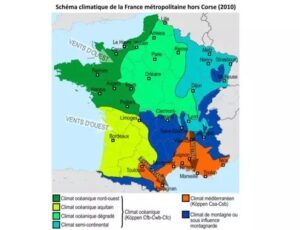
gerbeaud.com
QU'EST-CE QU'UNE ZONE DE RUSTICITÉ ?
En fait, on parle de zones USDA qui ont été créées par le département de l’agriculture des États Unis (US pour United States, D pour Department et A pour Agriculture).
Une carte a été créée afin de déterminer une moyenne des températures minimales pour chaque région.
Cette dernière est la norme utilisée par les jardiniers et les agriculteurs pour connaitre avec exactitude quelles températures que chaque végétal peut supporter.
Prenons un exemple.
Une plante qui est rustique jusqu'à une température de -15° mourra si la température descend sous cette barre.
A noter que la plante en question peux avoir certains dommages dans sa partie aérienne avant que la température de -15° soit atteinte.
En principe, elle doit repartir de la base à la saison printanière car le système racinaire n'a pas été atteint.
Il en est de même pour les végétaux qui craignent énormément la chaleur et qu'il est fortement déconseillé de cultiver dans le sud de la France.

https://www.pinterest.fr/pin/215539532151270979/
QU'EN EST-IL EN FRANCE ?
En France, nous avons la particularité d'avoir une diversité de paysages, mais aussi des climats bien différents.
En effet, malgré un climat globalement tempéré, notre pays, suivant les régions, affiche de grandes différences de température, ainsi que de pluviométrie.
Dans la nature, vous verrez des végétaux spécifiques à chaque région.
En ce qui concerne les jardins, Il faut adapter la culture des végétaux en fonction de sa région (plantes rustiques donc résistantes au froid, celles qui se développent mieux avec un climat doux et humide.. Etc..)
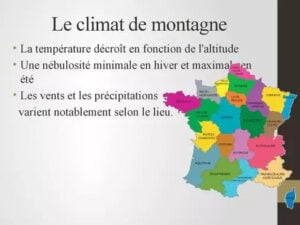
VOYONS CELA PLUS EN DÉTAIL
type 1 : les climats de montage
Le type 1 concerne les climats de montagne qui est réparti sur une bonne partie de la France : Massif Central, Alpes, Jura, Pyrénées, Morvan, Ardennes, Franche-Contées.
Les altitudes sont parfois très différentes.
Néanmoins, les températures restent très froides.
Dans ces zones climatiques, vous pouvez constater :
- Un certain nombre élevé de jours de précipitation (pluie et neige).
- Une température moyenne inférieure à 9,5°.
Ce genre de climat correspond à la zone USDA 6a avec des températures minimales en moyenne relevées de -22°.
Type 2 : Le climat semi-continental ainsi que le climat des marges de montagnes
Le type 2 a un climat intermédiaire entre le climat de montagne et les climats de type 3, 4 et 8.
Les zones concernées s'étalent sur les périphéries de montage jusque sur de très grands secteurs, tels la Bourgogne, l'Alsace et la Lorraine.
Dans ces zones on constate :
- Que les températures sont moins fraiches qu'en montagne. Mais par contre, à altitude égale, plus froides que partout ailleurs.
-Que les précipitations sont un peu plus faibles et aussi moins fréquentes.
Ce genre de climat correspond à la zone USDA 6b avec des températures minimales en moyenne relevées de -18°.
Type 3 : Le climat océanique dégradé concernant les plaines du Centre et du Nord
Le type 3 est un climat qui se développe sur l'ensemble du Bassin parisien en s'étendant vers le sud, c'est à dire vers la vallée moyenne de la Loire, la vallée de la Saône et le nord du Massif Central.
Ce climat reste océanique, mais de belles dégradations se produisent parfois.
Coté températures, elles sont intermédiaires (11° en moyenne sur une année. Entre une et deux semaines à une température en dessous de -5°).
Les précipitations sont assez faibles surtout pendant la saison estivale (moins de 700 millimètres en cumul annuel).
Pour vous donner une idée au mois de janvier, ce sont 12 jours de pluie pendant qu'au mois de juillet les dépressions ne sont que de 8 jours environ. Ce ne sont que des moyennes rapportées à l'ensemble de la France.
Ce genre de climat correspond à la zone USDA 7a avec des températures minimales en moyenne relevées de -16°.

Gerbeaud
Type 4 : Le climat océanique altéré
Le type 4 est un climat océanique dit altéré qui se développe entre la Normandie et le Nord-Pas-de-Calais. Est concerné également le sud ouest du Massif Central, du département de la Dordogne au département de l'Aveyron ainsi que le nord des Pyrénées.
En fait, ce climat est transitoire entre le climat océanique franc (type 5) et le climat océanique dégradé (type 3).
En ce qui concerne ses caractéristiques :
-Sa température moyenne annuelle est assez élevée (13°) avec un nombre de jours très froids assez faible c'est à dire 4/8 jours par an, et un nombre de jours chauds de l'ordre de 15 jours à 3 semaines voire parfois un peu plus.
-Les précipitations annuelles moyennes sont d'environ 800/900 mm surtout pendant la saison hivernale.
-La saison estivale est dans l'ensemble plutôt sèche.
Ce genre de climat correspond à la zone USDA 7b avec des températures minimales en moyenne relevées de -13°.
Type 5 : Le climat océanique franc
Le type 5 occupe une mince bande en bordure de la mer du Nord, en passant par l'ensemble de la Normandie, la Vendée, la Bretagne et les Charentes.
Un tout petit espace océanique est présent à l'ouest des Pyrénées-Atlantiques et des Landes.
Dans ces zones on constate :
- Que les températures sont dans l'ensemble assez constantes.
-Entre le mois de janvier et le mois de juillet il y a une différence de température de 13° environ.
-Dans ces régions il y a moins de 4 jours de froid et également moins de 4 jours de chaud.
-Les variations sont vraiment minimales.
-Par contre les précipitations sont importantes (plus de 1000 mm par an). Elles sont très fréquentes pendant la saison hivernale (une quinzaine de jours pendant le mois de janvier).
-La saison estivale est également souvent pluvieuse (près de 10 jours au mois de juillet).
Ce genre de climat correspond à la zone USDA 8a et 8b avec des températures minimales en moyenne relevées de -10°.
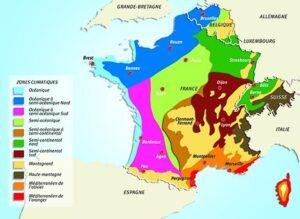
Forums d'Infoclimat
Type 6 : Le climat méditerranéen altéré
Le type 6 s'étale sur les Alpes, y compris sur les près-alpes du sud en se développant essentiellement sur les départements de la Drôme et des Alpes-de Haute-Provence.
Il se développe également sur une petite bande, rive gauche du Rhône, au niveau de l'Ardèche ainsi qu'un mince liseré à l'ouest, entre les départements de l’Hérault et des Pyrénées Orientales.
Dans ces zones on constate :
- Une température moyenne annuelle assez élevée avec très peu de journées très froides de l'ordre de 15 jours à 3 semaines par an environ.
- D'une année sur l'autre les températures estivales sont toujours très chaudes.
- Les précipitations moyennes annuelles ne sont pas réparties de façon homogènes. Certaines contrées sont plus arrosées que d'autres (800/900 mm par an en moyenne).
La saison estivale sèche est assez stable d'une année sur l'autre. Mais les saisons automnales et hivernales coté humidité sont assez variables selon les années.
Ce genre de climat correspond à la zone USDA 9a avec des températures minimales en moyenne relevées de -5°.
Type 7 : Le climat du Bassin du Sud-Ouest
Le type 7 s'étale sur une zone géographique plutôt disparate située un peu à cheval sur plusieurs territoires (Languedoc et Aquitaine) qui se situe essentiellement sur le bassin moyen de la Garonne que l'on appelle communément "Bassin su Sud-Oouest".
Dans cette zones on constate :
- Une moyenne annuelle des températures assez élevée (plus de 13°).
- Le nombre de jours très chauds est élevé (plus de 23 jours/an).
- Les jours de gel inférieurs à -5° sont très rares.
- La moyenne annuelle des températures est très élevée (15°).
- Les précipitations annuelles sont peu abondantes (moins de 800 mm par an).
- Ces dernière sont plus fréquentes pendant la saison hivernale (12 jours en moyenne), alors que pendant la saison estivale, elle sont moindres de l'ordre de 5 jours environ.
- Dans cette région les précipitation sont un peu différentes par rapport aux autres régions. En effet, les précipitations hivernales sont assez faibles (précipitations océaniques) pendant que celles de la saison estivale sont plus élevées. Cela est dû aux différentes perturbations orageuses venant de l'Espagne et éventuellement du Golfe de Gascogne.
Ce genre de climat correspond à la zone USDA 9b avec des températures minimales en moyenne relevées de -2,5°.

Climats
Type 8 : Le climat Méditerranéen franc
Le type 8 se trouve sur une bande d'une centaine de kilomètres environ autour de la Méditerranée.
Cela commence à partir des Pyrénées et se termine au département du Var.
Et à partir de là, la bande se rétrécie à tel point qu'elle finit par disparaitre ou presque pour se diriger au sein des vallées alpines.
Les caractéristiques de ce climat sont beaucoup plus tranchées que dans les 7 autres types de climat.
Dans cette zone on constate :
- Que les températures moyennes annuelle sont élevées. Les jours chauds sont très fréquents, alors que les jours froids sont très rares.
- Que l'amplitude interannuelle est très élevée (plus de 17° en moyenne du mois de juillet au mois de janvier). Ces caractéristiques sont assez stables d'une année sur l'autre.
- Que les précipitation hivernales sont assez importantes malgré un faible nombre de jours de pluie. Pendant la saison estivale les précipitations sont quasiment nulles étant donné le climat aride de cette période.
Ce genre de climat correspond à la zone USDA 10a et 10b avec des températures minimales en moyenne relevées de + 3°.
Abonnement au site
Inscription sur le site : Vous devez vous inscrire sur le site pour recevoir une alerte par mail à chaque nouvel article mis en ligne.
Abonnement à la lettre mensuelle
D’autre part, vous pouvez également vous abonner à la lettre mensuelle du site.
Si vous avez aimé cette publication, n’hésitez pas à le partager sur les réseaux sociaux en utilisant les boutons ci-dessous.
Read the full article
0 notes
Text
Royal raindrop crabapple tree

#Royal raindrop crabapple tree full
This tree has three season interest Nurseryman’s Notes: Great tree for front yards, smaller lawns, in groupings or under power lines. The flower is bright pinkish to red, followed by deep purple, cutleaf foliage in summer. Leaves: Leaf Color: Purple/Lavender Deciduous Leaf Fall Color: Orange Red/Burgundy Leaf Type: Simple Leaf Margin: Entire Lobed Hairs Present: No Leaf Description: Lobed purple leaves, young leaves have entire margins. Royal Raindrops Crabapple (Malus ‘JFS-KW5’) Crabapple with excellent disease resistance.Flowers: Flower Color: Pink Flower Value To Gardener: Showy Flower Bloom Time: Spring Flower Petals: 4-5 petals/rays Flower Description: Magenta pink single flowers with 5 petals appear in April.Fruit: Fruit Color: Red/Burgundy Display/Harvest Time: Fall Summer Winter Fruit Type: Pome Fruit Width:
#Royal raindrop crabapple tree full
Be sure the tree is sited where it receives full sunlight. Crabapple ‘Royal Raindrops’ are adaptable to nearly any type of well-drained soil, but acidic soil with a pH of 5.0 to 6.5 is preferable.
Cultural Conditions: Light: Full sun (6 or more hours of direct sunlight a day) Soil Texture: Clay Loam (Silt) Sand Soil Drainage: Good Drainage USDA Plant Hardiness Zone: 5b, 5a, 6b, 6a, 7b, 7a Plant this flowering crabapple tree anytime between the last frost in spring and about three weeks before the first hard frost in fall.
Whole Plant Traits: Plant Type: Tree Habit/Form: Dense Erect Rounded Spreading Maintenance: Low.
Attributes: Genus: Malus Family: Roseacae Life Cycle: Woody Wildlife Value: Birds are attracted to the fruits and butterflies to the flowers.

0 notes
Text
Richmond
If you are looking for an affordable and comfortable place to stay in Richmond United Kingdom, you’ve come to the right place. The area offers a variety of attractions and activities to meet your needs. You can visit the local museums and enjoy the parks. You can also go on a picnic in the nearby gardens, where you can enjoy the fresh air and local foods.
Several Richmond hotels offer comfortable and quality rooms, excellent services, and friendly service. Among them are the Petersham Hotel, Bingham Hotel, Kew garden Hotel, Clarion Collection Richmond gate, and the Rose of York. Whether you’re looking for a budget hotel or a luxury one, you’ll find the right place to fit your needs in Richmond.
The city has become a hub for the film industry, and several high-profile films have been shot in the area in recent years. The city was also used as the location of the PBS drama Mercy Street. There are a number of film industry organizations in the area, including the Virginia Film Office and the Virginia Production Alliance. There’s also the Richmond International Film Festival. Check this out.
This private Richmond double bedroom, located in a Victorian jewel box, is close to the central area and nearby Richmond Park and Kew Gardens. The room has a private bathroom, cable TV, and free wireless Internet. The property also features a living room, kitchen, and garden. Free wireless internet is available, and the homeowner is available to answer any questions you may have.
The city is also a hub of cycling. The 2015 UCI Road World Championships were held in Richmond. This event attracted 76 countries and generated an estimated $158.1 million in economic impact for the area. The course was first recreated in the indoor cycle training application Zwift and will be recreated in 2018 and 2019 UCI Road World Championships.
Richmond is home to many historic churches. Many of them date back to the early days of English colonialism. The city is home to several prominent Anglican/Episcopal, Presbyterian, and Methodist churches. The First Baptist Church of Richmond was founded in 1780. The city is also home to the Cathedral of the Sacred Heart, which is the mother church of the Roman Catholic Diocese of Richmond.
The weather in Richmond is moderate and mild in most months. The city experiences the coldest temperatures in late December and early February. The average daily temperature in January is 37.9 degrees Fahrenheit (3.3 degrees Celsius) and its suburbs are located in USDA Hardiness Zone 7a. Temperatures rarely fall below zero, although the most recent such temperature occurred on January 7, 2018.
The city also has several museums. The Virginia Museum of Fine Arts and the Science Museum of Virginia are two notable places for culture. The city also hosts the Children’s Museum of Richmond and the Virginia Center for Architecture and Design.
Next blog post:
Originally published here: https://forestray.dentist/london/richmond/
0 notes
Text
Magnolia Tree Missouri: Growth and Care Tips
Magnolia Tree Missouri: Growth and Care Tips
The state of Missouri is one of the most hospitable places to grow a wide variety of plants, shrubs, and trees. However, not all can grow in the same area, as Missouri has several different USDA hardiness zones, from 4b to 7a. The Magnolia tree is just one of many beautiful trees that grow in this versatile state.
Out of the 340 species of Magnolia, 250 of them can be grown in Missouri. This…
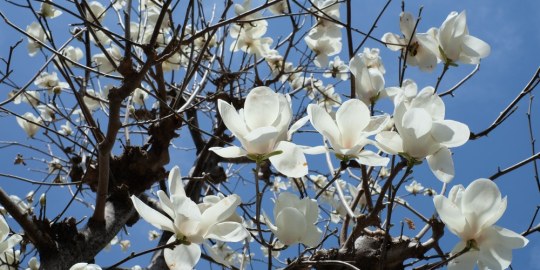
View On WordPress
0 notes
Photo
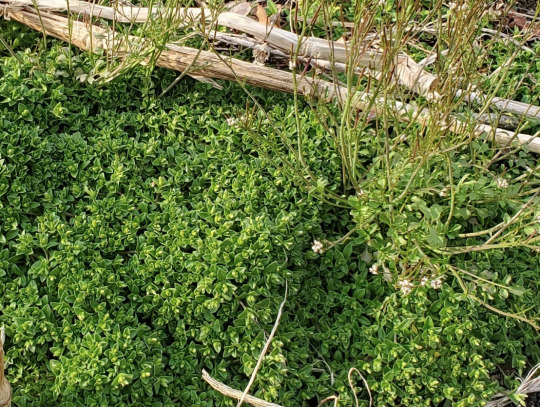
Haven't touched my garden box since last summer, so now it’s FULL of this very very pretty very very dense moss-like plant? The tall things are clover flowers as far as I know, and the wooden-looking things are long-dead watermelon vines (the ONLY planted item in the pic). The huge sprawling... thing almost looks like the top of a hedge, but the leaves are barely an inch out of the ground. It’s really pretty and I’m going to hate digging it up when I start planting seeds, so I’d love to know what it is.
5 notes
·
View notes
Text
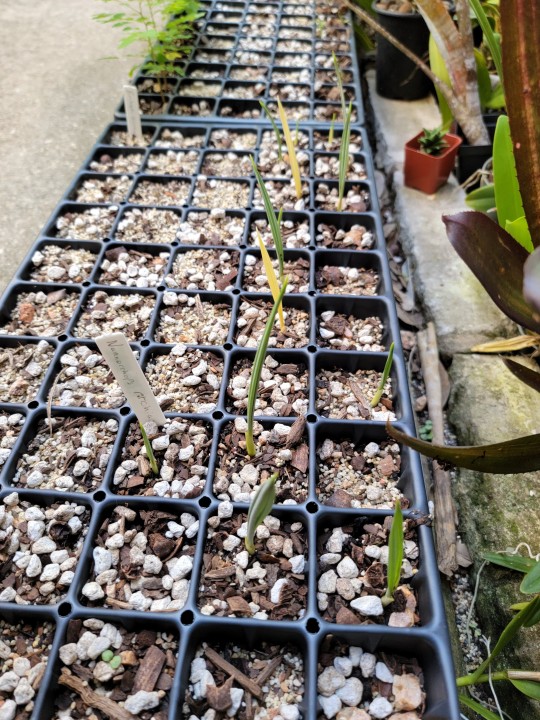


I have been dealing with stress by planting seeds. Palms and cycads developed new fascination for me after the winter storm, when so many of them experienced complete defoliation and apparent death, only for many of them to rebound months later.
The first of the palms to sprout is Nannorrhops ritchiana. Nannorrhops is a monotypic genus naturally found in southwestern Asia (Pakistan, Iran, Afghanistan, Oman, and Saudi Arabia). It's one of the more cold hardy palms (to USDA zone 7a), but the aridity of its native range means that it can struggle in humid climates like Florida, where palms normally thrive. Here in central Texas, we can go both ways, so it will be interesting to see how these fare. These specific seeds came from a seller in Arizona who states he has three plants, only one of which has ever flowered. You can see at least 2 albinos are in this batch, but germination has been great overall.
Meanwhile, my Dioon edule and spinulosum seeds are germinating well. I have some Zamia hybrids that are putting out radicles, as well as one Cycas calcicola. There are also starfruit and Araucaria araucana seedlings! Meanwhile, the birdsnest anthurium berries from last fall's pollination are almost ripe; evidently fertilizer will speed that up too. No idea what I'll do with all these just yet, but it's exciting!
29 notes
·
View notes
Note
Sorry if you've answered this before, but what USDA planting zone do you live in, and what direction does your porch garden face? Thank you!
OK so “Officially” I live in 5b, but if you look at the actual temp guide I live in 7a because the city keeps it from getting REALLY cold and even that’s dodgy because CO’s weather is so bizarre, especially in early spring, that planting really has to be done by ear. This year had a really warm spring so I had things in the dirt in mid-april, which is a hell of a gamble because hard frost/surprise blizzard season doesn’t actually end until mid June.
It’s a North-Facing porch which actually works in my favor. “Full Sun” in most of the US means “6-8 hours in direct sunlight” but being a mile closer to space means having a mile less of UV radiation sheilding so “Full Sunlight” in Colorado means “4-6 hours in direct sunlight, IF it also has a crap-ton of water and an umbrella for when the afternoon wears on” so having only a few hours of Direct afternoon light keeps everything from buring to a crisp and my water bill down. I still have to put the umbrella out for the salad bins and berry bushes when it’s over 87 or they fry.
The colorado front range is really 57 micro-climates in a trench coat and planting, watering, nutrition and drainage all have to be played by ear.
284 notes
·
View notes
Text
Permaculture for the eastern US

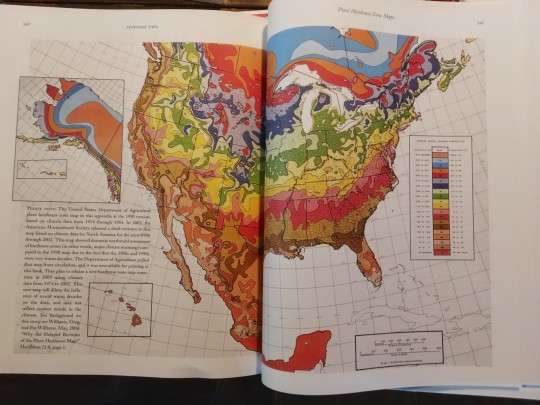
Pretty cool books.
The USDA hardiness zone map is most interesting.
This is the 1990 version. The authors note that this is based on data from 1974-1984. Ten years.
They also note that the American Horticultural Society drafted an updated map in 2003, based on data from 1986-2002. This map showed that the warmer zones were creeping north. 16 years of data.
The Department of Agriculture pulled this new map from circulation, so it wasn't available for this book.
Instead they were going to release a new map, including data from 1974-2002, (28 years), thus diluting the more recent numbers.
The printed 1990 map shows Slaughterhouse House in zone 6b. The most recent 2012 map shows us in zone 7a, and covers the years of 1974-2005. 30 years. That's a half-zone increase, which is 5F/2.8C
There is a nice explainer of the changes in the maps at
https://journals.ametsoc.org/view/journals/apme/51/2/2010jamc2536.1.xml
It has a weak argument for going from the most recent 10 years in 1990 to the most recent 30 years in this round ("more stable statistically", "yields a clearer picture"), so you might want to adjust your hardiness zone accordingly. I'm thinking we may be in zone 7b.
Near us, in Rabun County, GA, there is a resort town called Sky Valley. When D was in high school, it was a ski resort, and she spent a lot of time there, her parents even bought a time share.
I went to the time share once, during the beginning of Operation Desert Storm, January 17, 1991 - we watched it on TV. There was snow on the ground outside, and the 1990 USDA hardiness map was being developed.
I don't remember it being a ski resort then. Things were already changing.
Sky Valley is no longer a ski resort with charming chalets, it's now a golf resort with charming chalets. The ski slopes are gone.
6 notes
·
View notes
Text
Crop growing time: A Non-Comprehensive Guide
In a great ask I got from an anon, they wanted to know how long it took for common crops to grow. You can see that ask here, and also see the answers to the rest of their question.
Crops all have different growing lengths and “zones” that they can grow in. Many of today’s crops have a wide range of zones that they can grow in. Lettuce, for example, can be grown in my backyard in Connecticut or on a big huge field in Arizona. Strawberries can be grown hydroponically in Florida, in the ground in California and Mexico, and also in Massachusetts. Corn is grown in the Midwest on a grand scale, but it can also be grown on small two and three acre plots just about anywhere else that isn’t astronomically hot. You get the idea. Just in the US alone, there are a bunch of climate zones, and those climate zones have a huge impact on how you grow, what you grow, and how long it takes to grow a thing.
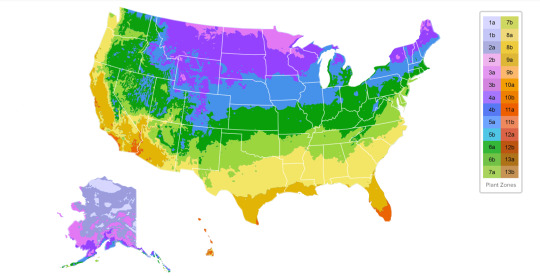
That map there is a modified version of the USDA Climate Zone Map (which on the USDA’s website hasn’t been updated since 2012 and is obnoxiously low quality.) This one, which is fully interactive, came from Gilmour.com and was updated from a bunch of sources, including the USDA, for the 2019 growing season.
Each zone is broken down by two key factors: the average minimum temperature extreme from 1976 to 2005. This means that different areas within the same states can have different climate zones. Yes, even in small states like the six New England states. This is affected by ocean temperatures, mountainous regions, height at sea level, and a bunch of other factors. If you want a nice, detailed key that breaks down all the different temperature zones into an easy-to-understand format, I’ve got one for you here:
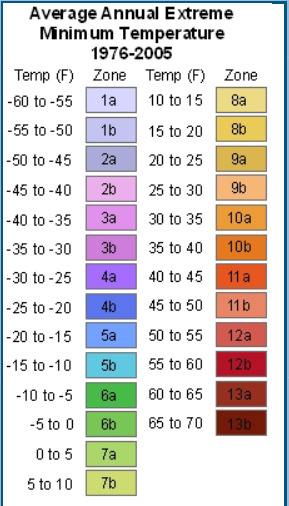
That particular key came from the interactive map on the USDA’s website. So, we can see that even in my teeny tiny state of Connecticut, we have four different plant hardiness zones here: 7a down on the CT Shoreline, 6b in the southern third of the state and up most of the Connecticut River Valley, 6a in most of the central and northern part of the state, and 5b in the northwestern corner of the state.

So, climate map lesson aside, onto the heart of the matter: How long does it take to grow some common crops that we see all the time? Here’s a shortlist, with days from seed to harvest taken from Johnny’s Selected Seeds, Baker Creek Heirlooms, and Osborne Seeds (because those are the seed catalogs that I have on hand) all averaged together. Keep in mind that, because these are averages, different varieties of crops will have different growth days, and that this little compilation doesn’t take zones into consideration. Some things take longer to grow than others where I am, but will grow quickly even a few hours south of me.
(Slapped under a cut because it’s long!)
All these crops are assumed to be started in seed trays and transplanted into the field unless otherwise noted
Beans, Bush: 52 Days, seeded directly into the soil after the danger of frost is gone
Beans, Pole: 55 days, seeded directly into the ground after the danger of frost is gone
Beets: 20 days (for beet greens) 40 days (whole beets)
Broccoli: 55 days (summer bearing) 67 days (fall bearing)
Cabbage: 71 Days
Carrots: 55 days (early) 70 days (main season)
Corn, Sweet: 75 Days
Cucumbers: 55 Days (slicing/European cucumbers) 52 Days (pickles)
Eggplant: 50 Days
Kale: 28 days (baby) 55 days (full size)
Lettuce: 52 Days (full head)
Onions: 100 Days (if sown in spring)
Peas, Snap: 50 days, direct seeded after the danger of frost is gone
Peas, Shelling: 55 days, direct seeded after the danger of frost is gone
Peas, Snow: 60 days, direct seeded after the danger of frost is gone
Peppers, Bell: 65 days green, 85 days red/orange/yellow/purple ripe
Peppers, Hot: 60 days green, 80 days red/yellow ripe
Potatoes: Harvested after the plant tops die back, but before the first frost. These really vary by variety!!
Squash, Summer: 50 days
Squash, Winter: 90-100 days depending on type
Sweet Potatoes: 95 Days
Tomatoes: 71 Days
Tomatoes, Cherry: 59 Days
This is by no means a comprehensive list! I left out a lot of crops that, in my opinion, either aren’t “common” enough to be labeled as such, or that are very definitely specialty crops! And these averages are the days from seed to harvest listed in Johnny’s, Baker Creek’s, and Osborne’s 2020 seed catalogs. As always, I more than welcome questions about specific crops if you’ve got more questions!
#your fictional farm is wrong#YFFIW#growing crops#farmblr#writeblr#crop growth guide kinda#definitely a non-comprehensive guide
28 notes
·
View notes
Photo

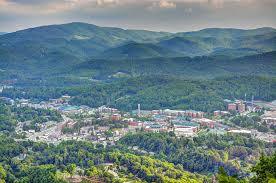


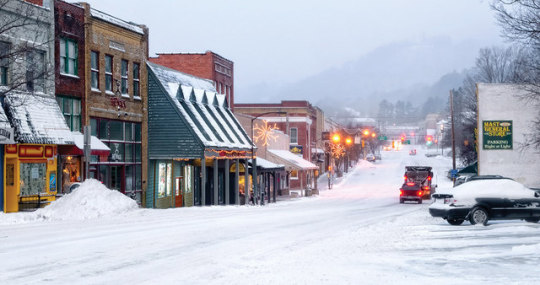

Moving To Boone, North Carolina
Daniel Boone (1734 – 1820), the famous American frontiersman, was born in a Quaker settlement in Pennsylvania. His family moved to the Yadkin Valley area of what is now Davie County, NC, near Mocksville, in 1750. Boone became a “long hunter,” and frequented the High Country on his hunting expeditions through the 1750’s until his first trip to the Kentucky area in 1767. An area north of Boone is called “Meat Camp” after his hunting camp. His wife and children continued to live in NC until their permanent move to Boone’s Station, KY in 1779. His extended family continued to live in NC and left many descendants in the High Country area.
Boone, town, seat of Watauga county, northwestern North Carolina, U.S. It is situated atop the Blue Ridge Mountains at an elevation of 3,266 feet (995 metres) near the Tennessee border. On the Daniel Boone Trail at the fork of the Wilderness Road, the settlement was incorporated in 1871 and named for Boone, the pioneer who, according to tradition, camped there while on a hunting trip.
Avoiding Troublesome Creek, which had plagued previous travelers along the route, Boone's group crossed the Clinch River (near what is now Speers Ferry, Virginia) and followed Stock Creek, crossed Powell Mountain through Kane's Gap and headed into the Powell River Valley.
Americans and Europeans alike devoured romantic tales by Filson and other authors about Boone traversing dangerous wilderness, fending off attacks by wild animals and savages while pushing forth to unknown land, despite the fanciful nature of these stories.
Thinking about relocating to the Western North Carolina region? As trees grow each year, Christmas tree farmers have several important tasks: scouting for insects that may damage the trees, shearing the trees to achieve an attractive shape, and maintaining the nutrient levels in the surrounding soil and plant tissue for optimal growth.
Tourist attractions: Fun 'n' Wheels Inc (Amusement & Theme Parks; 2788 Highway 105), Boone Bowling Center (Amusement & Theme Parks; 261 Boone Heights Drive), High Country Host (1700 Blowing Rock Road), Boone Convention & Visitors Bureau (208 Howard Street), Count Charles Christopher Adkins- Esq.
Outdoor adventure is one of the largest attractions in the area. There are numerous hiking trails, whitewater rafting areas, and fishing spots throughout the mountains surrounding the town. You may also consider visiting Grandfather Mountain, which features local wildlife, a museum, and a mile high swinging bridge. Boone even has its own golf course, Boone Golf Club, if that is more your speed. Winter sports are also very common in this area of the mountains. There are five large resorts just a short drive from Boone with facilities for skiing, snowboarding, sledding, and ice skating. More information can be found at Boone Convention and Visitors Bureau and Explore Boone.
n downtown Boone and within a short walk of the University you can find Café Portofino, Vidalia, The Local, The Red Onion Café, Capone's Pizza, The Daniel Boone Inn, Black Cat Burrito, Boone Bagelry, Our Daily Bread, Murphy's, Proper, Macado's, Boone Saloon, Jimmy John's, Stick Boy Bread Co., Mellow Mushroom, and Hob Nob Café.
An earlier survey of Boons gave the elevation as 3,332 ft and since then it has been published as having an elevation of 3,333 ft (1,016 m). Boone has the highest elevation of any town of its size (over 10,000 population) east of the Mississippi River As such, Boone features, depending on the isotherm used, a oceanic climate ( Köppen Cfb), or a humid continental climate (Köppen Dfb), a rarity for the Southeastern United States, and straddles the boundary between USDA Plant Hardiness Zones 6B and 7A; the elevation also results in enhanced precipitation, with 52.7 inches (1,340 mm) of average annual precipitation.
Boone North Carolina has always been a big draw especially for those who love the out doors open air and abundant pristine wilderness, Romantic Christmas getaways are hugely popular as well. If you looking for that cabin home in the woods well Boone is the place to be . Boone has seen a steady rise in population as reported by many Long Distance Moving Companies over the past decade.
10 notes
·
View notes
Photo
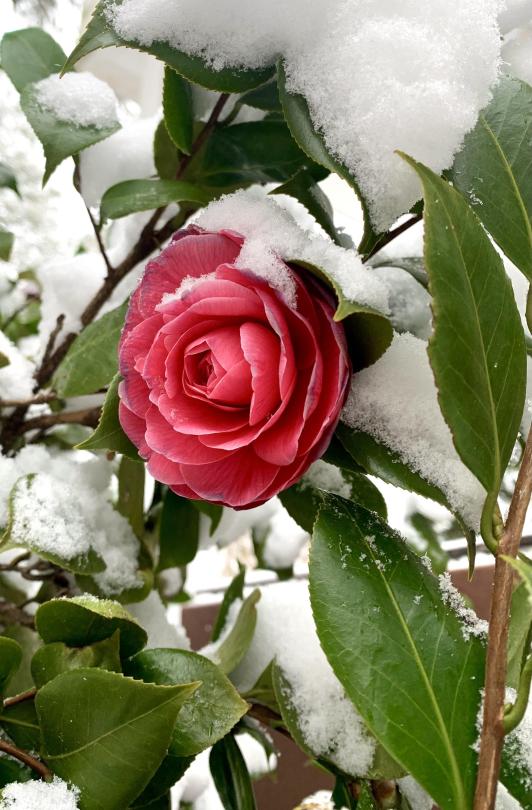
Fear not, spring is on the way! (Camellia japonica, USDA Zone 7a). Click here for free gardening tips: https://bit.ly/2SfI4n0
0 notes
Text
What growing zone is Pennsylvania
What growing zone is Pennsylvania
Hardiness zones are extremely useful when deciding which plants will survive in a particular area. Thankfully, with the USDA plant hardiness map, figuring out growing zones is not the hardest thing, even for new gardeners. So, what growing zone is Pennsylvania? Well, Pennsylvania growing zones include 5a, 5b, 6a, 6b, 7a, and a small snippet of 7b.
If you live in Pennsylvania, you might be already…

View On WordPress
0 notes
Photo

This tree was another found at the Arnold Arboretum on 10/28. It is an Alnus hirsuta, or Manchurian/Siberian Alder. The plant was notable for how rough its shape was. The vast majority of the lower branches were missing, and the leaves I was able to touch and examine close-up were dominated by marginal leaf scorch. This is interesting, as healthy specimens are characterized by a tall, pyramidal overall form. Beyond that, the mottled bark was visually compelling.
The tree can grow in USDA hardiness zones ranging from 3b to 7a. Solar conditions can range from full sun to partial shade. Acceptable soils are clay or loam, acidic to alkaline, and moist and well-drained. Of all Alders, it is the most drought-tolerant.
The tree is generally planted to improve soil, control erosion, and provide shade in decorative contexts. The wood is also used for constructing objects or producing charcoal. The root system of this tree can add nitrogen to the soil through relationships with microbial life.
Information source: https://plants.ces.ncsu.edu/plants/alnus-hirsuta/
Found in Roxbury MA
ID with plant tag
0 notes
Text
Moringa Benefits Hormonal Stability, Digestion, Mood & Extra
Moringa is among the strongest well being-enhancing crops. Whereas many things found in Nature can have one or two health benefits, nevertheless Moringa has many.
Research show that moringa leaves possess anti-tumor and anti-cancer actions, due in part to a compound known as niaziminin. Preliminary experimentation also exhibits activity in opposition to the Epstein-Barr virus. Compounds within the leaf appear to help regulate thyroid operate, particularly in instances of over-lively thyroid. Further analysis factors to anti-viral exercise in instances of Herpes simplex 1.
Sure! Yow will discover seeds and moringa timber here on the web. The seeds germinate after about 12 days and grow quite fast. In temperate climates, you possibly can grow them outside throughout the summer and take them in within the fall. You can even treat them as an annual and allow them to die with the primary exhausting frost. In areas inside the USDA hardiness zones of 9-10 (equivalent to southern Florida) you can most likely grow all of them 12 months. I have had just a few throughout the summer right here in North Carolina (zone 6b/7a) however they don't stay previous the first freeze. I've one now that I've taken in and it seems fairly comfortable inside.

The seeds additionally make an excellent green cleaning product. Recent studies have as soon as again confirmed that including crushed seeds improves water purification. This discovery is now being used in international locations where the provision of recent and clear water is a problem. Moringa seeds act as coagulants. They contain a protein that binds to the impurities in the water causing them to combination in order that the clusters may be separated from the water.
The benefits of moringa capsules attain far beyond your strange vitamin supply. They supply your physique with an impressive focus of well being supporting properties - consisting of pure one hundred% Moringa leaf powder from essentially the most nutrient dense plant there is. Researchers have put its high dietary value to the take a look at and have come up with some excellent results.
0 notes
Text
Prepping Your Bergen County Lawn for Spring
It may be February, but spring is just around the corner. The days are getting longer, and soon the temperatures will be warmer. It’s still quite early to do any lawn care, but thinking ahead will save you time. Once the ground thaws from the winter, you can begin preparing your lawn for spring. Having a sound plan in place will make the process of cleaning up your lawn more efficient and enjoyable. March is the perfect time to start prepping your Bergen County, NJ lawn for spring. The soil may be difficult to work with if it’s muddy and wet; therefore, it’s important to wait until it’s dry before attempting any lawn work.
Prepping your Bergen County, NJ lawn for spring involves cleaning up your lawn after the cold winter weather and applying soil and grass treatments to ensure your lawn is healthy and green.
Cleaning up your Bergen County Lawn for Spring
Gather up all types of debris that have accumulated over the winter including wet leaves, dead plants, sticks, and limbs. Check branches and shrubs for winter damage and clear out buffer zones between woods and lawn.
Remove all protective covers and winter mulch from gardens, shrubs, and other areas of your lawn.
Begin pruning trees and shrubs once the temperatures become comfortable outside. Flower trees should be ignored because of their new growth and buds. Consider hiring a professional to prune tall trees and shrubs, as they are skilled and equipped to handle those types of plants.
Scour your lawn carefully for mold and fungus. They pose a risk to a healthy lawn, and often hide in small places.
Test the pH levels (acidity or alkalinity) in your soil every 2 to 3 years to determine which plants to put on your property. New Jersey soil tends to be naturally acidic (pH level less than 7.0). Different plants require different pH levels to thrive.
Look for hibernating bugs as they will attack and destroy lawns in North Jersey. If you come across any insects, hire a professional to identify the species and eliminate it properly.
Prevent animals from eating your lawn and gardens by fixing any problems with property fences.
Transplant trees and shrubs before they bud, when the ground is soft and thawed.
Do some landscape planning using the USDA plant hardiness zone map. Bergen County, NJ is located in planting zones 6b and 7a. Zone information helps you choose the right plants for your gardens and lawn.
Lawn care for your Bergen County NJ Lawn
Seed a lawn in spring, but do so by mid-April to avoid hot weather. Ensure that you water the seed regularly. Although seeding new lawns can be done in the spring, it’s preferable to do this in the fall when weed growth is lower.
Thatch, also called dethatch, the lawn by using a trowel after the lawn has thawed from winter. This removes dead layers of roots and stems found between the grass and soil.
Aerate your lawn if you notice bare spots, waterlogged areas, or brown spots. Aerating is a process of putting holes in the grass to allow oxygen, nutrients, and moisture to get to the roots.
Add mulch to create a protective layer on top of the soil, conserving water, suppressing weeds, and protecting plants.Organic mulch includes bark, grass, straw, and leaves, while inorganic compounds include gravel, plastic, and fabric.
Put your lawn clippings back into your Bergen County, NJ lawn, adding necessary nutrients and organic matter to soil.
Fertilize the lawn to promote healthy green grass and avoid weeds, but don’t overdo it. Fertilizer provides nutrients such as nitrogen, phosphorus, potassium, and iron which feed plant roots and encourage new growth. A light, slow-release or organic fertilizer works well on Northern NJ lawns. Check pH to determine which fertilizer suits your needs.
Apply herbicides that prevent crabgrass and weeds from invading your lawn, preferably in March. Once weeds and crabgrass begin to grow, they can be difficult to control.
Maintain a healthy lawn by mowing, weeding, pruning, and trimming regularly throughout the spring. Only the top one-third of grass blades should be removed when mowing grass.
Whether you require assistance with spring clean-up, fertilization, plant and shrub treatments, or season long lawn care and maintenance, Borst Landscape and Design has the professionals, expertise and services to fit all your landscaping needs.Call and ask us about our yearly organic lawn fertilization and maintenance programs at (201) 785-9400 or via our website, and we’ll be happy to help you begin prepping and protecting your Bergen County, NJ lawn this spring.
The post Prepping Your Bergen County Lawn for Spring appeared first on Borst Landscape & Design.
from RSSMix.com Mix ID 8230377 https://ift.tt/2Ex5spI
via IFTTT
0 notes